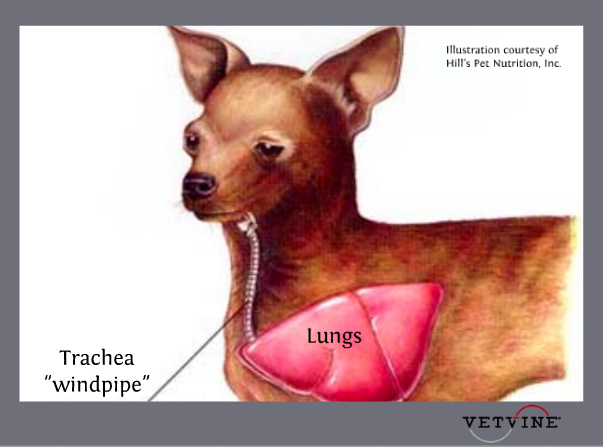Tracheal Collapse
Contributed by: VetVine Specialty Consulting Service and Elisabeth Zenger, DVM, PhD, DACVIM (Small Animal Internal Medicine)
The trachea ("windpipe") is an anatomic structure that connects the larynx to the lungs. The trachea carries inhaled air into the lungs, and as the animal exhales, the trachea carries it away.

The trachea maintains it's rigid tubular shape due to the presence of tracheal rings. The rings are somewhat round in shape and are made up of cartilage. If the cartilage becomes weakened, the tubular shape of trachea can become compromised due to collapsing of the rings. This results in a narrowing of the airway.
Causes
This condition is inherited and primariy seen in toy and small breeds of dogs. Affected dogs have a primary defect in the tracheal ring cartilage that leads to weakening and decreased rigidity in its structure.
Signs
Coughing is typical in affected dogs and can be exacerbated with exercise, any pressure around the neck, or during periods of stress. Symptoms can be seen as early as 6 months of age (in about 25% of cases), but most dogs develop problems during middle age (6 to 7 years of age).
Progression and Complicating Factors
The airway can become narrow or flattened due to weakening and degeneration of the cartilage. Over time, the rings collapse further especially with persistent coughing. The coughing leads to inflammation which exacerbates the coughing - all of which becomes a "vicious" cycle.
Complicating Factors that can affect the progression of this condition:
When it Becomes an Emergency
Diagnosis
The veterinarian uses several pieces of information to confirm the diagnosis:
Treatment
Chronic medical treatment with drugs to suppress coughing and minimize inflammation is essential. Medications may be given orally and/or by an inhaler. In some cases bronchodilators are also used.
Minimizing any of the complicating factors is critical in helping affected patients including:
In some instances, medical therapy is not enough. Tracheal stenting can be performed as a means of restoring the tubular shape and conformation of the trachea.
Prognosis
This condition is chronic and can be progressive, thus requiring long term medical therapy to control coughing and inflammation. In dogs that require stenting, the prognosis is good - with 75% to 95% of dogs seeing improvement with the procedure. Complications are rare, however dogs usually do continue to require long-term follow up and medical management.